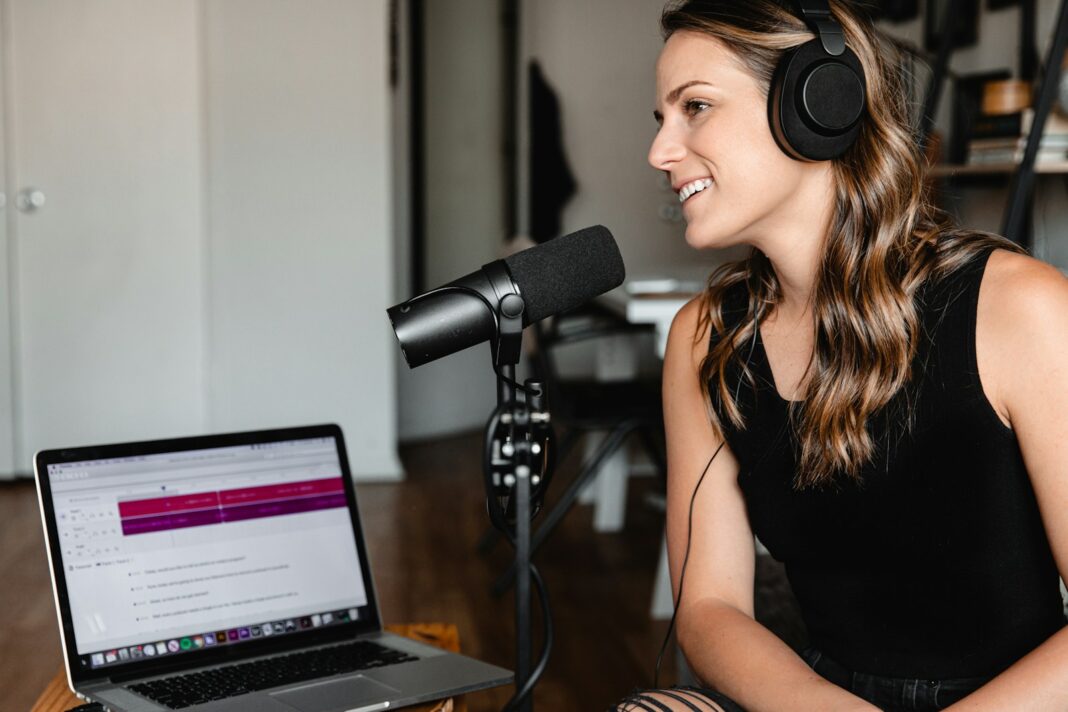Hey, fabulous future podcaster! If you’ve been dreaming about having your own podcast where you can share your stories, ideas, and voice with the world, then welcome to your ultimate guide! Whether you want to start something on the side for fun or have grand plans of building a podcast empire, I’ve got you covered. Think of this as your step-by-step blueprint to get your podcast off the ground, with plenty of tips and tricks to make sure you start strong.
Starting a podcast can feel overwhelming at first, but don’t worry! You can do this without breaking the bank, and I’ll be guiding you through options from low-budget to medium-budget, depending on where you want to invest. Ready to jump in and make your podcast dreams come true? Let’s dive into these 10 essential steps to launching your own successful podcast, with a dash of fun, a sprinkle of creativity, and, of course, lots of YOU!
Step 1: Find Your Podcast Passion and Niche
The very first step to starting a successful podcast is figuring out what you want to talk about. It’s easy to say, “I want to have a podcast,” but what will it be about? Finding a topic that you’re truly passionate about is key to keeping your energy up episode after episode.
Here are some questions to ask yourself:
- What do I love talking about for hours?
- What unique experiences or knowledge do I have?
- Who do I want to reach with my message?
Maybe you’re a fitness enthusiast, a lover of all things beauty, or a mom with amazing tips on work-life balance. Whatever it is, make sure it’s something that excites you, because that energy will translate to your listeners.
Fun Podcast Topic Ideas:
- The Mindful Glow-Up: A podcast about self-care, mindfulness, and mental wellness.
- The Badass Mom Diaries: Tips, stories, and laughter from moms juggling careers, kids, and life.
- Green Glamour: All about sustainable fashion and eco-friendly beauty routines.
- Pop Culture Confessions: Chat about the latest in TV, movies, celebrity gossip, and music.
- Girls Who Geek: Dive into your fandoms—whether it’s Marvel, gaming, or Star Wars—with a female perspective.
Once you have your topic, narrow it down to a niche. For example, if you’re interested in health and wellness, maybe your niche could be wellness for busy women or how to stay fit after 40. Having a niche helps you attract a specific, engaged audience faster.
Step 2: Name It Like a Boss
Next up—naming your podcast! Your podcast name is super important because it’s the first thing people will see. You want it to reflect your content, be catchy, and (very importantly) be easy to remember.
Tips for Choosing the Perfect Podcast Name:
- Keep it short and sweet: No one wants to remember a podcast name that’s 12 words long.
- Be descriptive but fun: Make sure it hints at what your podcast is about but still shows off your personality.
- Check for availability: Is the name taken? Google it, check podcast directories, and see if the domain name is available (you might want a website later).
Examples:
- Glow & Grow for a podcast about personal development.
- Chic in the City for an urban lifestyle and fashion podcast.
- Boldly Balanced for a show about work-life balance and thriving as a modern woman.
Pro Tip: Once you land on a name, secure the social media handles and domain name even if you aren’t ready to launch the website. Consistent branding will help build your audience faster!
Step 3: Choose Your Format and Episode Structure
There are many ways to structure a podcast, and this is where you can get creative. Decide how you want to present your content and how often you’ll release episodes.
Different Podcast Formats:
- Solo Podcast: It’s just you, your mic, and your fabulous thoughts. Perfect if you love talking and have a lot of knowledge to share.
- Co-hosted Podcast: Grab a friend or business partner and have fun chatting back and forth. Co-hosting adds a fun dynamic and makes episodes feel conversational.
- Interview Podcast: You interview guests on a specific topic. This is great for expanding your audience and bringing in experts.
- Storytelling: Think true crime or narrative podcasts. These are scripted shows that dive into a story over multiple episodes.
Pro Tip: If you’re unsure, start with solo episodes to get comfortable, then branch out into interviews as you gain confidence.
Episode Length:
Decide how long your episodes will be. There’s no “right” length, but most successful podcasts tend to be 30-45 minutes. However, you could go as short as 15 minutes or as long as an hour—it’s up to you and your audience’s attention span!
Step 4: Get Your Equipment (Without Breaking the Bank)
Now that you’ve got your topic and format figured out, it’s time to talk gear. Don’t worry, you don’t need to spend thousands of dollars to start podcasting. There are plenty of budget-friendly options that still deliver great sound quality.
Low-Budget Setup (Under $200):
- USB Microphone: Start with a good quality USB mic like the Blue Yeti ($120) or Audio-Technica ATR2100x($99). These are plug-and-play, easy to use, and sound fantastic.
- Recording Software: Use free software like Audacity or GarageBand for recording and editing.
- Pop Filter: A simple pop filter ($10) will help eliminate those annoying “p” and “b” sounds that can pop on the mic.
- Headphones: You don’t need fancy ones! Any good-quality closed-back headphones (like Sony MDR-7506, $99) will work.
Medium-Budget Setup (Under $500):
- XLR Microphone: For even better sound quality, upgrade to a microphone like the Shure SM7B ($400), but you’ll need an audio interface (like the Focusrite Scarlett 2i2 for $160) to connect it.
- Audio Interface: The Focusrite Scarlett 2i2 will let you connect multiple mics for interviews or co-hosted episodes.
- Acoustic Treatment: For better sound in your recording space, consider getting a few foam panels ($50-$100) to reduce echo.
No matter your budget, good sound quality is essential to keeping your audience coming back, so invest in the best microphone you can afford. Pro Tip: Record in a small, quiet space like a closet to help reduce background noise.
Step 5: Plan Your Episodes and Content
Consistency is key! Before you launch, it’s a good idea to plan out your first few episodes and have them ready to go. Not only does this help you stay on track, but it also ensures that you won’t be scrambling to release episodes every week.
Things to Plan:
- Episode Titles: Brainstorm titles that are clear and intriguing. Think of them like headlines—people should want to click and listen!
- Episode Structure: Decide if you’ll have segments, interviews, or a regular format to follow. For example, maybe you open with a listener question, dive into the main topic, and close with a quick tip or resource.
- Call to Action: What do you want listeners to do at the end of each episode? Subscribe, leave a review, or follow you on Instagram? Make sure you mention it!
And remember, batch recording is your best friend! Record 3-4 episodes at once, then release them consistently over the next few weeks. This will help you avoid burnout and keep your podcast schedule consistent.
Step 6: Record and Edit Like a Pro
Recording your first episode might feel a little nerve-wracking, but trust me, it gets easier! Once you’ve got your equipment set up and your episode planned, it’s time to hit record.
Recording Tips:
- Mic Placement: Keep your microphone about 6-8 inches from your mouth. Speak directly into the mic for the best sound, but don’t get too close—you don’t want to create distortion.
- Quiet Environment: Make sure your room is quiet—turn off the AC, fans, and anything else that might create background noise.
- Relax: Remember, you’re just chatting! If you stumble over your words or lose your train of thought, don’t panic. You can always edit later.
Editing:
Editing might sound intimidating, but basic editing is pretty simple once you get the hang of it. Use Audacity or GarageBand (both free) to cut out any awkward pauses, “umms,” or mistakes. Over time, you’ll get quicker at it.
Step 7: Get Your Podcast Online
Congratulations! You’ve recorded your first few episodes, and now it’s time to put your podcast out into the world. This is where you’ll need a podcast hosting platform. These services store your podcast files and distribute them to podcast directories like Apple Podcasts, Spotify, and Google Podcasts.
Low-Budget Podcast Hosting Options:
- Buzzsprout (Free for up to 2 hours per month, then starts at $12/month for more features).
- Anchor (Free, with monetization options, but limited analytics).
- Podbean (Starts at $9/month).
Once you upload your episodes, the hosting platform will give you an RSS feed, which you’ll submit to directories like Apple Podcasts, Spotify, and more. This makes it easy for listeners to find and subscribe to your show!
Step 8: Promote, Promote, Promote!
Getting your podcast live is only the first step. Now you need people to actually find it! Promoting your podcast is all about reaching your target audience and building a community of listeners.
Ways to Promote Your Podcast:
- Social Media: Share your episodes on Instagram, Twitter, and Facebook. Create fun teaser clips or behind-the-scenes content to get people excited.
- Email Newsletter: Build an email list from day one and send out updates every time you release a new episode.
- Collaborate with Other Podcasters: Guest on other podcasts or invite them onto your show to cross-promote.
- Submit to Podcast Directories: Make sure your show is listed on all major platforms like Apple Podcasts, Spotify, Google Podcasts, Stitcher, and iHeartRadio.
- Ask for Reviews: Ask your listeners to leave reviews—it helps boost your podcast’s visibility in the rankings!
Step 9: Monetize Your Podcast (If You Want!)
Once you’ve built a loyal audience, you might want to start monetizing your podcast. There are several ways to do this, and the right method depends on your content and your audience size.
Monetization Options:
- Sponsorships: As your podcast grows, brands may want to sponsor your show. These deals typically involve reading an ad during your episodes.
- Affiliate Marketing: Promote products or services you love, and earn a commission for every sale made through your unique affiliate link.
- Listener Donations: Set up a Patreon page where listeners can support your show in exchange for exclusive content or early access to episodes.
- Courses or Products: If you’re an expert in your field, you could create a course, e-book, or product and promote it on your podcast.
Just remember, focus on growing your audience before diving too deep into monetization. Brands and sponsors will be more interested in partnering with you once you have a solid listener base.
Step 10: Stay Consistent and Keep Evolving
The key to podcast success is consistency. Stick to your posting schedule, and always look for ways to improve. Pay attention to listener feedback, study your download stats, and keep refining your content to provide even more value.
Keep Your Audience Engaged:
- Engage with your listeners: Respond to comments on social media, answer listener questions on your show, or create a Facebook group for your audience.
- Keep learning: There’s always something new to learn in podcasting. Whether it’s audio editing techniques, marketing tips, or better interview skills, always strive to improve.
And most importantly—have fun! Podcasting is a creative journey, and it’s all about connecting with people who resonate with your voice and message.
Let’s Get Your Podcast Off the Ground!
There you have it—10 steps to get your podcast off the ground and set yourself up for success. Podcasting is a fantastic way to share your passion, build a community, and make your mark in the world. Whether you’re on a tight budget or ready to invest a bit more, the key is to start small, stay consistent, and keep growing.
Remember, every successful podcaster started right where you are now—with a microphone, an idea, and a lot of heart. So get out there, press record, and let your voice shine!
Good luck, and I can’t wait to hear your first episode!




